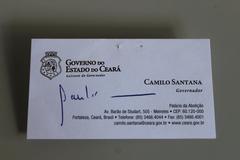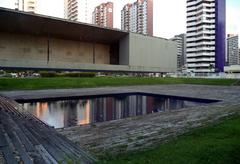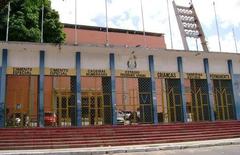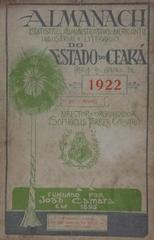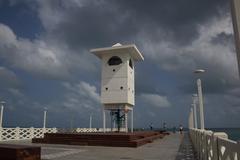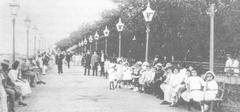Visiting Fortaleza de Nossa Senhora da Assunção in Fortaleza, Brazil
Date: 31/07/2024
Introduction
Fortaleza de Nossa Senhora da Assunção, located in the heart of Fortaleza, Brazil, is a historic fortress that stands as a testament to the city’s rich colonial history and cultural heritage. Constructed in the 17th century amidst the turbulent colonial conflicts between European powers, the fort has witnessed significant historical events that have shaped the region of Ceará. Initially built by the Dutch in 1649 as the Schoonenborch Fort, it was later reclaimed by the Portuguese in 1654 and renamed Fortaleza de Nossa Senhora da Assunção (Chasing the Unexpected, Wikipedia). This transformation marked the beginning of Fortaleza’s evolution from a military stronghold to a burgeoning town.
Over the centuries, the fort underwent several modifications and expansions, reflecting its enduring strategic importance and architectural evolution. Today, it serves as the headquarters of the 10th Military Region of the Brazilian Army and houses the Museum and Pantheon of General Sampaio, making it a significant cultural and historical landmark (Funceb, WhichMuseum). Visitors can explore the fort’s rich history through guided tours, which provide detailed insights into its architectural features and historical significance.
Table of Contents
- Introduction
- Historical Background
- Visitor Information and Tips
- Nearby Attractions
- Safety Tips
- Accessibility
- Local Customs and Etiquette
- Dining Options
- Souvenirs and Shopping
- FAQ
- Conclusion and Call to Action
Historical Background
Early Beginnings and Dutch Influence
The history of Fortaleza de Nossa Senhora da Assunção is deeply intertwined with the colonial conflicts between European powers in the 17th century. The region of Ceará, where the fort is located, was initially inhabited by indigenous tribes who found themselves caught in the crossfire of European colonization efforts. The first significant European structure in the area was the Fort of São Sebastião, constructed under the orders of Martim Soares Moreno to protect the land from Dutch invasions. However, this fort was short-lived due to its inadequate structure (Wikipedia).
In 1649, the Dutch returned to Fortaleza and established the Schoonenborch Fort, marking their second attempt to control the region. This fortification was strategically placed on the left bank of the Pajeú stream, on Marajaitiba hill, providing a vantage point over the surrounding landscape. The Dutch occupation lasted for seven years until 1654, when the Portuguese successfully expelled them and took control of the fort (Chasing the Unexpected).
Portuguese Reclamation and Transformation
Upon reclaiming the fort, the Portuguese renamed it Fortaleza de Nossa Senhora da Assunção on April 13, 1726. This renaming was not merely symbolic but also marked the beginning of Fortaleza’s transformation from a military stronghold to a burgeoning town. The fort’s strategic importance continued to be recognized, and it underwent several modifications and expansions over the years (Wikipedia).
In 1812, the then-governor of the Province of Ceará, Manuel Inácio de Sampaio e Pina Freire, initiated the construction of a new defensive structure on the site of the old fort. The cornerstone was laid on October 12, 1812, in honor of the birthday of Prince Dom Pedro de Alcântara. The new design, created by Lieutenant Colonel Engineer António José da Silva Paulet, featured a square layout with 90-meter sides and bastions at each corner named Nossa Senhora da Assunção, São José, Dom João, and Príncipe da Beira (Wikipedia).
Architectural Evolution and Military Significance
The construction of the new fort was a significant undertaking, funded by both public funds (20:362$390 réis) and private donations (16:113$267 réis), along with contributions of materials and labor from volunteers and enslaved people. Initially armed with five cannons, the fort’s artillery was expanded to 27 pieces by 1816. A commemorative plaque, originally placed on the north wall of the fort, is now housed in the Museum of the State of Ceará (Wikipedia).
The fort’s military significance continued well into the 20th century. Since September 17, 1948, it has served as the headquarters of the 10th Military Region of the Brazilian Army. This ongoing military presence underscores the fort’s enduring strategic importance and its role in the defense infrastructure of Brazil (Funceb).
Cultural and Historical Legacy
Today, Fortaleza de Nossa Senhora da Assunção is not only a military installation but also a significant cultural and historical landmark. It houses the Museum and Pantheon of General Sampaio, the patron of the Infantry Arm, and features a statue of Martim Soares Moreno. The fort also contains the cell where Bárbara de Alencar, a notable figure in Brazilian history, was imprisoned. These elements make the fort a rich repository of Brazilian history and heritage (WhichMuseum).
Visitor Information and Tips
Best Time to Visit
The optimal time to visit Fortaleza de Nossa Senhora da Assunção is during the dry season, which spans from August to December. During this period, the weather is warm and sunny, with temperatures ranging from 25°C to 30°C (77°F to 86°F), making it ideal for exploring the fortress and other outdoor activities. Avoid the rainy season from January to July, as heavy rains can disrupt your plans.
Getting There
Fortaleza de Nossa Senhora da Assunção is located in the heart of Fortaleza, making it easily accessible by various modes of transportation. If you are staying in the city center, you can reach the fortress by walking or taking a short taxi ride. For those staying further away, public buses and ride-sharing services are convenient options. The nearest major airport is Pinto Martins – Fortaleza International Airport, approximately 10 km from the city center.
Entrance Fees and Operating Hours
The fortress is open to the public from Tuesday to Sunday, typically from 9:00 AM to 5:00 PM. It is advisable to check the official website or contact the local tourism office for the most up-to-date information on operating hours and any special events that might affect access. Entrance fees are generally modest, often around BRL 10-20, but prices can vary depending on the season and any special exhibitions.
Guided Tours
To fully appreciate the historical and cultural significance of Fortaleza de Nossa Senhora da Assunção, consider joining a guided tour. These tours are often available in multiple languages, including English, Portuguese, and Spanish. Guides provide in-depth information about the fortress’s history, architecture, and its role in the development of Fortaleza. Tours can be booked in advance through local tour operators or directly at the fortress.
What to Wear
Given Fortaleza’s tropical climate, lightweight and breathable clothing is recommended. Opt for comfortable walking shoes, as you will likely spend a considerable amount of time exploring the fortress grounds. Don’t forget to bring a hat, sunglasses, and sunscreen to protect yourself from the sun. If you plan to visit during the rainy season, a light rain jacket or umbrella is advisable.
Photography Tips
Fortaleza de Nossa Senhora da Assunção offers numerous photo opportunities, from its impressive architecture to panoramic views of the city. Early morning or late afternoon provides the best lighting for photography, reducing harsh shadows and glare. Be mindful of any photography restrictions, especially in areas with historical artifacts or exhibits. Drones are generally not permitted without prior authorization.
Nearby Attractions
While visiting the fortress, take the opportunity to explore nearby attractions. The Mercado Central de Fortaleza is a bustling market where you can purchase local crafts, souvenirs, and sample regional cuisine. The Catedral Metropolitana de Fortaleza, another historical landmark, is within walking distance and worth a visit for its stunning architecture. For a more relaxed experience, head to Praia de Iracema, a popular beach nearby.
Safety Tips
Fortaleza is generally safe for tourists, but it is always wise to take precautions. Keep your belongings secure and be aware of your surroundings, especially in crowded areas. Avoid displaying valuable items such as expensive jewelry or large amounts of cash. Stick to well-lit and populated areas, particularly at night. If you are unsure about the safety of a particular area, consult with your hotel staff or local authorities.
Accessibility
Fortaleza de Nossa Senhora da Assunção is committed to being accessible to all visitors. Ramps and elevators are available for those with mobility issues, and accessible restrooms are provided. If you require special assistance, it is advisable to contact the fortress in advance to ensure that your needs can be accommodated.
Local Customs and Etiquette
When visiting historical sites like Fortaleza de Nossa Senhora da Assunção, it is important to respect local customs and etiquette. Dress modestly, especially if you plan to visit religious sites within the fortress. Refrain from loud conversations and disruptive behavior. Always ask for permission before taking photographs of people, particularly locals. Learning a few basic phrases in Portuguese, such as “por favor” (please) and “obrigado” (thank you), can go a long way in showing respect and appreciation for the local culture.
Dining Options
After exploring the fortress, you might want to enjoy a meal at one of the nearby restaurants. Fortaleza offers a variety of dining options, from casual eateries to fine dining establishments. Try local dishes such as “moqueca” (a seafood stew) or “acarajé” (deep-fried balls of black-eyed pea dough filled with shrimp). For a quick snack, street vendors offer a range of delicious treats, including “pastel” (fried pastry) and “tapioca” (a type of crepe made from cassava flour).
Souvenirs and Shopping
Before leaving, consider purchasing some souvenirs to remember your visit. The Mercado Central de Fortaleza is an excellent place to find unique items such as handmade crafts, jewelry, and textiles. Look for items made from local materials like lace, leather, and wood. Additionally, the fortress gift shop often carries a selection of books, postcards, and other memorabilia related to the site’s history.
FAQ
Q: What are the visiting hours for Fortaleza de Nossa Senhora da Assunção?
A: The fortress is open from Tuesday to Sunday, typically from 9:00 AM to 5:00 PM. It’s advisable to check the official website for any changes in operating hours.
Q: How much are the entrance fees?
A: Entrance fees usually range from BRL 10-20, depending on the season and any special exhibitions.
Q: Are guided tours available?
A: Yes, guided tours are available in multiple languages and can be booked in advance or at the fortress.
Q: Is the fortress accessible for visitors with mobility issues?
A: Yes, ramps, elevators, and accessible restrooms are available to accommodate visitors with mobility issues.
Conclusion and Call to Action
Fortaleza de Nossa Senhora da Assunção stands as a remarkable monument that encapsulates the rich colonial history and cultural heritage of Fortaleza, Brazil. From its early beginnings as a Dutch fort to its reclamation and transformation by the Portuguese, the fortress has played a pivotal role in the region’s historical narrative. Today, it continues to serve as a cultural and historical landmark, offering visitors an immersive experience through its museum, guided tours, and panoramic views.
Whether you are a history enthusiast, a cultural explorer, or simply a curious traveler, Fortaleza de Nossa Senhora da Assunção provides a unique opportunity to delve into Brazil’s colonial past. By following the visitor tips and information provided in this guide, you can ensure a memorable and enriching visit to this iconic site. For more travel guides and updates, consider downloading the Audiala app, following on social media, and exploring other related posts on our website.
References
- Wikipedia. (n.d.). Fortaleza de Nossa Senhora da Assunção. Retrieved from https://pt.wikipedia.org/wiki/Fortaleza_de_Nossa_Senhora_da_Assunção
- Chasing the Unexpected. (n.d.). Stronghold Church of Nossa Senhora da Assunção or Where Fortaleza Was Born. Retrieved from https://www.chasingtheunexpected.com/stronghold-church-of-nossa-senhora-da-assuncao-or-where-fortaleza-was-born/
- Funceb. (n.d.). Fortaleza Nossa Senhora da Assunção. Retrieved from https://www.funceb.org.br/fortaleza-nossa-senhora-da-assuncao
- WhichMuseum. (n.d.). Fortress of Our Lady of the Assumption, Fortaleza. Retrieved from https://whichmuseum.com/museum/fortress-of-our-lady-of-the-assumption-fortaleza-23343
